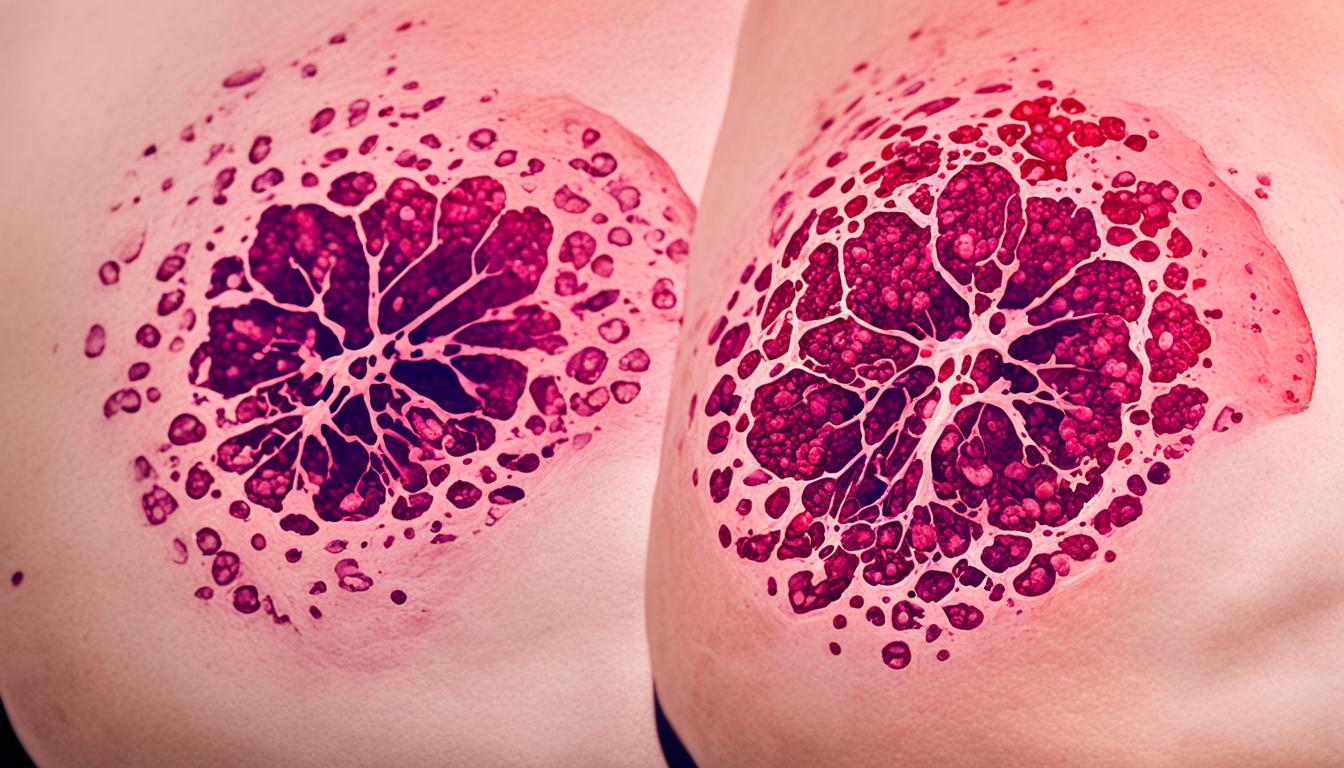Inflammatory breast cancer (IBC) is a rare and aggressive form of the disease. It makes the breast look red, swollen, and warm. Unlike common breast cancers, there are no lumps in IBC. Usually, it’s felt as if the breast is thick or heavy.
The exact cause of IBC is unclear. However, it’s thought to result from both genetic and environmental reasons. Doctors look for it through a clinical exam and then confirm with a breast biopsy. For treatment, options include chemotherapy, targeted therapies, and sometimes, stem cell treatments.
Stem cell therapy is a new method. Here, the patient’s own stem cells help the breast tissue heal. Studies are still investigating how effective this is for IBC.
Key Takeaways:
- Inflammatory breast cancer is a rare and aggressive form of breast cancer.
- IBC causes the breast to become red, swollen, and warm, with a thick or heavy feeling.
- Diagnosis of IBC is typically made through a clinical exam and confirmed with a breast biopsy.
- Treatment options for IBC may include chemotherapy, radiation therapy, targeted therapy, and stem cell therapy.
- Stem cell therapy is an innovative approach that uses the patient’s own stem cells to help regenerate damaged breast tissue.
Symptoms and Diagnosis of Inflammatory Breast Cancer
Inflammatory breast cancer (IBC) is rare but very aggressive. Early detection is key for effective treatment. It’s essential to know the signs and how it’s diagnosed. This helps raise awareness and ensures quick help for better results.
Symptoms of Inflammatory Breast Cancer
IBC shows different symptoms than other breast cancers. Knowing these signs helps find the disease early.
- Red, swollen, and warm breast: IBC often makes the breast look red, feel warm, and swell.
- Thick or heavy feeling: A sense of heaviness or thickness in the breast might signal IBC.
- Dimpled or pitted breast skin: Occasionally, the skin can look dimpled or pitted.
- Nipple changes: Any change in the nipple, like pulling in or flattening, can be a sign.
- Nipple discharge: Odd nipple fluids, especially blood or clear liquid, should be checked by a doctor.
Remember, these symptoms can point to other breast issues too. Always see a doctor for an accurate diagnosis.
Diagnosis of Inflammatory Breast Cancer
Finding IBC starts with a deep look by a doctor. They want to rule out other breast problems. Here’s what the diagnosis might involve:
- Clinical exam: Doctors look for telltale signs in the breast and lymph nodes, like redness and swelling.
- Imaging tests: Mammograms, ultrasounds, and MRIs take detailed pictures to help diagnose IBC.
- Breast biopsy: Confirming cancer means taking a small piece of breast for lab testing to look for cancer cells.
If you notice IBC symptoms, get medical help fast. Early diagnosis and treatment vastly increase chances of a good outcome.
Innovative Treatment Approaches for Inflammatory Breast Cancer
Inflammatory breast cancer’s treatment combines various therapies. It focuses on using different methods together for the best outcome. The main choice is chemotherapy. This treatment tries to make the cancer smaller before surgery. Chemotherapy uses strong drugs. It works all over the body to stop the cancer from spreading again.
Radiation therapy is also key. It uses strong radiation to kill any leftover cancer cells. It comes after chemotherapy and surgery. This step lowers the risk of the cancer coming back. It also makes the overall treatment more successful.
For some patients, doctors might suggest targeted therapy. This kind of treatment is for cancers that have certain receptors on them. HER2-targeted therapies are a type of targeted therapy. They aim specifically at the cancer cells. They leave the healthy cells alone. This way of treating the cancer is tailored to the patient. It has had good results.
A more recent approach to treating inflammatory breast cancer is stem cell therapy. This uses the patient’s own stem cells. The goal is to fix and regrow the damaged breast tissue. Studies are still going on. But, early signs show this could be a great way to improve treatment results for patients.
Choosing the right treatment for someone with inflammatory breast cancer involves talking to a specialized doctor. They will look at the person’s situation closely. Then, they will design a treatment plan. This plan might include chemotherapy, radiation therapy, targeted therapy, or even stem cell therapy. The aim is to use the best treatments that suit that person’s needs.

